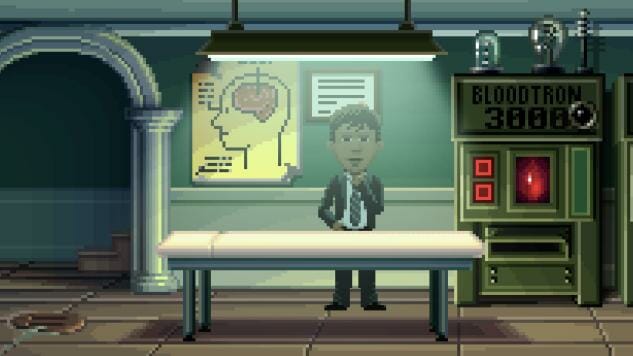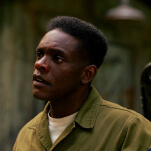Thimbleweed Park’s Wireframe Writing Betrays Its Hefty Puzzles

For the first two hours or so, Thimbleweed Park, the latest game by ex-LucasArts adventure game vets Ron Gilbert and Gary Winnick, convinces players that they are in for a standard murder mystery. It introduces its first two main characters, Agent Ray and Reyes, through snappy banter that feels reminiscent of Mulder and Scully from The X-Files. Ray comments on how the dead body before them is starting to “pixelate”, which Reyes jots down in his journal like an eager student. It was a cute moment, despite the grim situation at hand. I didn’t mind the game proclaiming “We’re in a video game!” so blatantly and so early into the game. There’s nothing wrong with a welcoming wink and nod, as long as it leads to something more.
Seven hours into the game, I find myself in control of five different characters, with access to a variety of locations. The two FBI agents have been relegated to walking inventories, accompanied by an über-geek game designer, a foul-mouthed circus clown, and a ghost. What distinguishes these other characters from their duller counterparts are unique moments of characterization early in the game: Dolores, the game designer, torn between her dreams and her rich uncle’s wishes; Ransome the Clown, whose vitriolic standup leads to his mystical downfall; and Franklin, an inventor whose ambitions and needs are suppressed by his meekness, both in life and death. These moments offer promising glimpses into something deeper than just a murder mystery, hinting at themes about family dysfunction, corporate intrusion, and the boundaries of comedy. However, sadly, all of this is put to the wayside once the ruse is up and the game’s intentions become clear: Thimbleweed Park is more invested in the logical efficiency of its puzzle design and incessant self-indulgent humor than developing any kind of originality and depth in its storytelling.
The former isn’t in and of itself a bad thing. The puzzles in Thimbleweed Park have a pace and structure that effectively correct the meandering, nonsensical design decisions of adventure games of yore. They are all very absurd in nature, but make sense within the universe the game exists in. The puzzles shine most brightly in the first three chapters, during the sections you play as the FBI agents. Their singular united goal of solving a murder case breaks down the task into a series of smaller puzzles, each one rewarding for the journey, not for the punchlines carried through. Exploring the town and talking to its peculiar residents at first feels fresh, genuinely evoking the best of its adventure game ancestry. Fresh enough to make the first signs of pronounced eye-rolling meta humor (“This cut-scene is starting to get long and it’s only going to get longer!”) and pop culture regurgitation seem inoffensive.
Once the gameplay shifts towards working on checklists rather than focused objectives, the mediocrity begins to show itself more clearly. It turns into a formula of passing items between characters who never properly meet or talk to each other, working as one mutually disconnected team. Puzzles grow wider but not deeper, by having the player constantly traverse multiple places for items and clues while abandoning any sense of direction. Environments start to lose their visual and tonal appeal the more they become vessels for nostalgic pandering. Each story revelation becomes a new chance to throw more boiler plate genre clichés into the pot, as if relying on TV murder mystery iconography wasn’t enough. Despite its visual crudeness by today’s standards, Gilbert’s seminal Maniac Mansion evoked B-movie sci-fi with a vivacious playfulness that revealed a genuine love for the subgenre. In Thimbleweed Park, sci-fi and horror are dismantled into various alluring pieces, each one used to desperately keep the player’s attention.








































